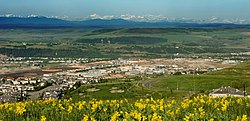| ||
|
| ||
 Distribution of Alberta's 269 urban municipalities | ||
Alberta has provincial legislation allowing its municipalities to conduct municipal censuses between April 1 and June 30 inclusive.[1][2] Due to the concurrency of Statistics Canada conducting the Canada 2016 Census in May 2016, the Government of Alberta offered municipalities the option to alter their 2016 municipal census timeframes to either March 1 through May 31 or May 1 through July 31.[3] Municipalities choose to conduct their own censuses for multiple reasons such as to better inform municipal service planning and provision, to capitalize on per capita based grant funding from higher levels of government, or to simply update their populations since the last federal census.[4]
With the dissolution of the villages of Galahad and Strome on January 1, 2016, Alberta had 354 municipalities in 2016.[5] Alberta Municipal Affairs recognized those conducted by 21 (5.9%) of these municipalities.[6] By municipal status, it recognized those conducted by 11 of Alberta's 18 cities, 5 of 108 towns, 2 of 90 villages, and 3 of 64 municipal districts.[6][a] In addition to those recognized by Municipal Affairs, a census was planned by the Village of Forestburg for 2016 but was subsequently deferred to 2017.[7]

Some municipalities achieved population milestones as a result of their 2016 censuses. Airdrie became the eighth city in Alberta to exceed 60,000 residents, while Leduc surpassed 30,000 people and Cochrane grew beyond the 25,000 mark. Edmonton fell short of the 900,000-mark by 553 people, while Red Deer dipped back below 100,000 residents after surpassing that milestone in 2015.
- ^ "Municipal Government Act: Revised Statutes of Alberta 2000 Chapter M-26 (Office Consolidation)" (PDF). Alberta Queen's Printer. November 24, 2010. Retrieved February 21, 2016.
- ^ "Municipal Government Act: Determination of Population Regulation, Alberta Regulation 63/2001 (Office Consolidation)" (PDF). Alberta Queen's Printer. 2013. p. 3. Archived from the original (PDF) on March 26, 2013. Retrieved February 21, 2016.
- ^ "Regular Council Meeting Agenda" (PDF). Mackenzie County. February 9, 2016. p. 148. Retrieved February 21, 2016.
In order to minimize the overlap between the federal and municipal census, Municipal Affairs will accommodate municipalities by giving them the option to alter their census enumeration period to either March 1, 2016 to May 31, 2016 or May 1, 2016 to July 31, 2016. For this census year only, municipalities are not required to submit a request for approval to the Minister if they choose to conduct a census during the two optional time periods offered.
- ^ "Municipal Census Manual: Requirements and Guidelines for Conducting a Municipal Census" (PDF). Alberta Municipal Affairs. February 2015. p. 7. ISBN 978-1-4601-2127-6. Retrieved February 21, 2016.
- ^ "2016 Municipal Codes" (PDF). Alberta Municipal Affairs. January 18, 2016. Retrieved February 21, 2016.
- ^ a b c "2016 Municipal Affairs Population List" (PDF). Alberta Municipal Affairs. ISBN 978-1-4601-3127-5. Archived from the original (PDF) on January 16, 2017. Retrieved January 13, 2017.
- ^ Cite error: The named reference
forestburgwas invoked but never defined (see the help page).
Cite error: There are <ref group=lower-alpha> tags or {{efn}} templates on this page, but the references will not show without a {{reflist|group=lower-alpha}} template or {{notelist}} template (see the help page).